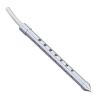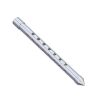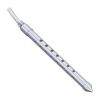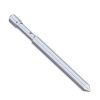Solinst Model 615S Shielded Drive-Point Piezometer
Features
- Affordable method to monitor shallow groundwater and soil vapor
- Attach to inexpensive 3/4" (20 mm) NPT steel drive pipe
- Can be used for permanent well points or short-term monitoring applications
- Expedited repair and warranty service
- Lifetime technical support
- More
Overview
The Solinst Model 615S shielded drive-point piezometer uses a high-quality stainless steel piezometer tip, 3/4" NPT pipe for drive extensions and LDPE or Teflon sample tubing, if desired. Combine these with an inexpensive Slide Hammer to create a complete system.
Design
The Solinst Model 615S shielded drive-point piezometer has a stainless steel, 50 mesh cylindrical filter-screen, within a 3/4" (20 mm) stainless steel drive-point body, screen support and a barbed fitting for attachment of sample tubing. Optional heavy-duty extension couplings are also available to create a strengthened and more rugged piezometer. The inner barbed fitting allows connection of 5/8" OD x 1/2" ID (16 mm x 12 mm) LDPE or Teflon sample tubing. This prevents sample water from contacting the steel extension rods, and maintains high sample integrity, even when inexpensive carbon steel extensions are used.
In The News
New map shows significant groundwater depletion in Central California
Groundwater level data collected by a Central California county shows significant drops during the past 12 years, according to a San Luis Obispo Tribune article. Data shows that groundwater has dropped by a minimum of 70 feet from 1997 to 2009 in the Paso Robles area of Central California. In the past four years the areas of most significant decline have expanded north and south. Drought and agricultural withdrawals are the likely culprits for the groundwater decline. Some advocates are calling for more responsible water use by vineyards in the area, while farmers note that the recent drought did not help the situation.
Read MoreWildfire Prevention in the Sierra Nevada Region with the Yuba Watershed Institute
Though recent wildfires have sparked new conversations about wildfire management and response, groups like the Yuba Watershed Institute have been monitoring the forests and water resources of the Sierra Nevada region for decades, managing approximately 5,000 acres of land with the Bureau of Land Management (BLM) and about 7,000 acres in private land partnerships. The goal of the Institute is to work with local communities and land agencies to improve watershed and forestry management through informed practices and public outreach. The goals of the Yuba Watershed Institute are three-fold: Improve the ability of fire suppression agencies like the California Department of Forestry and Fire Protection ( CAL FIRE ) and the US Forest Service.
Read MoreWave Sensors Integration with NexSens Buoys: A Cutting-Edge Solution for Wave Measurment
Real-time wave data supports accurate weather prediction, safe and efficient maritime operations, and provides valuable safety and operating condition information for recreation and commercial fishing. Understanding wave dynamics also helps with the design of protective coastal structures like seawalls, breakwaters, and jetties. It also supports better prediction of their impact on sediment transport and coastal geomorphology. Wave data is a key factor in qualifying and designing offshore wind farms and harnessing kinetic energy for electrical generation. It helps with the understanding of ocean-atmosphere interactions and contributes to studies of sea-level rise and climate change impacts.
Read More















